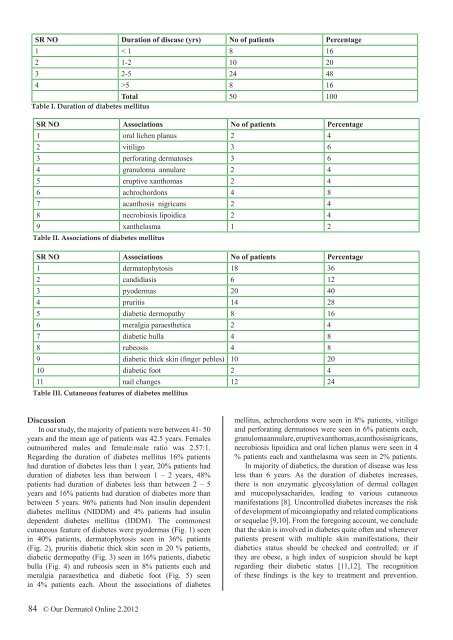download full issue - Our Dermatology Online Journal
download full issue - Our Dermatology Online Journal
download full issue - Our Dermatology Online Journal
Create successful ePaper yourself
Turn your PDF publications into a flip-book with our unique Google optimized e-Paper software.
SR NO Duration of disease (yrs) No of patients Percentage<br />
1 < 1 8 16<br />
2 1-2 10 20<br />
3 2-5 24 48<br />
4 >5 8 16<br />
Total 50 100<br />
Table I. Duration of diabetes mellitus<br />
SR NO Associations No of patients Percentage<br />
1 oral lichen planus 2 4<br />
2 vitiligo 3 6<br />
3 perforating dermatoses 3 6<br />
4 granuloma annulare 2 4<br />
5 eruptive xanthomas 2 4<br />
6 achrochordons 4 8<br />
7 acanthosis nigricans 2 4<br />
8 necrobiosis lipoidica 2 4<br />
9 xanthelasma 1 2<br />
Table II. Associations of diabetes mellitus<br />
SR NO Associations No of patients Percentage<br />
1 dermatophytosis 18 36<br />
2 candidiasis 6 12<br />
3 pyodermas 20 40<br />
4 pruritis 14 28<br />
5 diabetic dermopathy 8 16<br />
6 meralgia paraesthetica 2 4<br />
7 diabetic bulla 4 8<br />
8 rubeosis 4 8<br />
9 diabetic thick skin (finger pebles) 10 20<br />
10 diabetic foot 2 4<br />
11 nail changes 12 24<br />
Table III. Cutaneous features of diabetes mellitus<br />
Discussion<br />
In our study, the majority of patients were between 41- 50<br />
years and the mean age of patients was 42.5 years. Females<br />
outnumbered males and female:male ratio was 2.57:1.<br />
Regarding the duration of diabetes mellitus 16% patients<br />
had duration of diabetes less than 1 year, 20% patients had<br />
duration of diabetes less than between 1 – 2 years, 48%<br />
patients had duration of diabetes less than between 2 – 5<br />
years and 16% patients had duration of diabetes more than<br />
between 5 years. 96% patients had Non insulin dependent<br />
diabetes mellitus (NIDDM) and 4% patients had insulin<br />
dependent diabetes mellitus (IDDM). The commonest<br />
cutaneous feature of diabetes were pyodermas (Fig. 1) seen<br />
in 40% patients, dermatophytosis seen in 36% patients<br />
(Fig. 2), pruritis diabetic thick skin seen in 20 % patients,<br />
diabetic dermopathy (Fig. 3) seen in 16% patients, diabetic<br />
bulla (Fig. 4) and rubeosis seen in 8% patients each and<br />
meralgia paraesthetica and diabetic foot (Fig. 5) seen<br />
in 4% patients each. About the associations of diabetes<br />
mellitus, achrochordons were seen in 8% patients, vitiligo<br />
and perforating dermatoses were seen in 6% patients each,<br />
granuloma annulare, eruptive xanthomas, acanthosisnigricans,<br />
necrobiosis lipoidica and oral lichen planus were seen in 4<br />
% patients each and xanthelasma was seen in 2% patients.<br />
In majority of diabetics, the duration of disease was less<br />
less than 6 years. As the duration of diabetes increases,<br />
there is non enzymatic glycosylation of dermal collagen<br />
and mucopolysacharides, leading to various cutaneous<br />
manifestations [8]. Uncontrolled diabetes increases the risk<br />
of development of micoangiopathy and related complications<br />
or sequelae [9,10]. From the foregoing account, we conclude<br />
that the skin is involved in diabetes quite often and whenever<br />
patients present with multiple skin manifestations, their<br />
diabetics status should be checked and controlled; or if<br />
they are obese, a high index of suspicion should be kept<br />
regarding their diabetic status [11,12]. The recognition<br />
of these findings is the key to treatment and prevention.<br />
84 © <strong>Our</strong> Dermatol <strong>Online</strong> 2.2012















